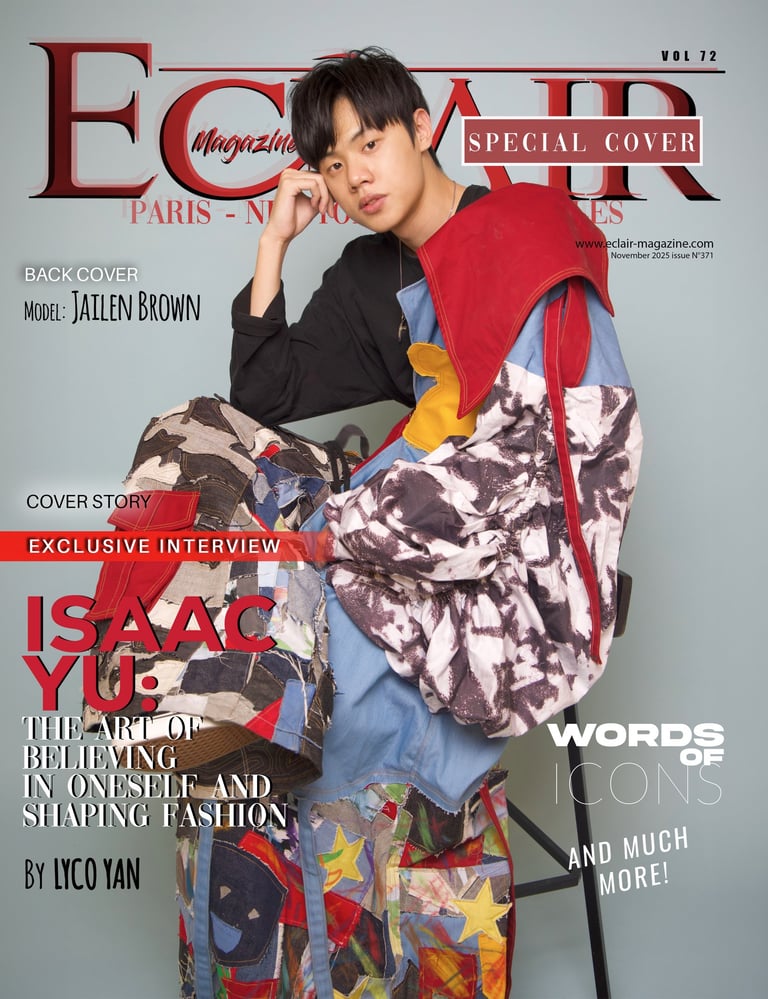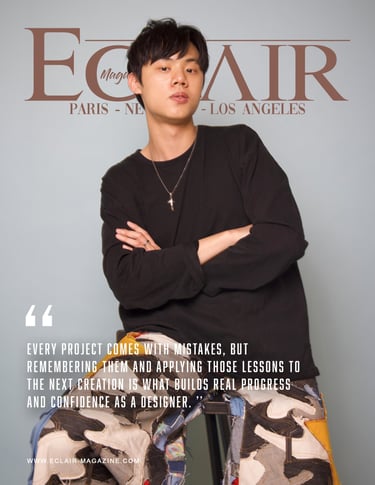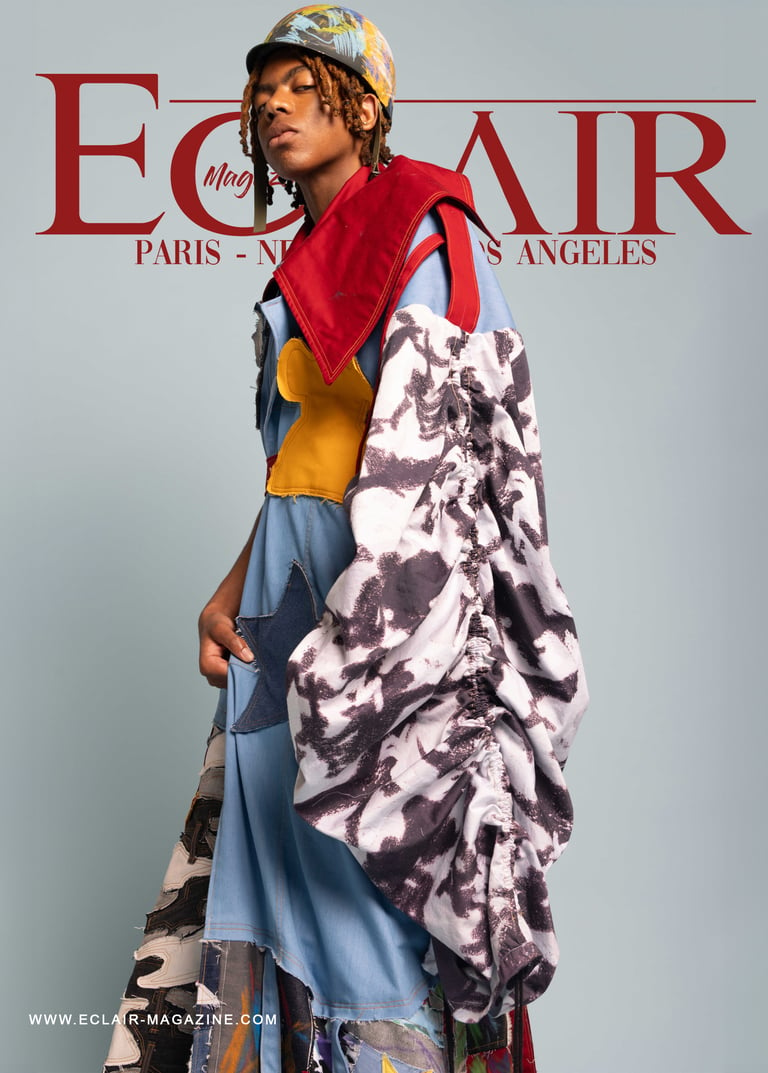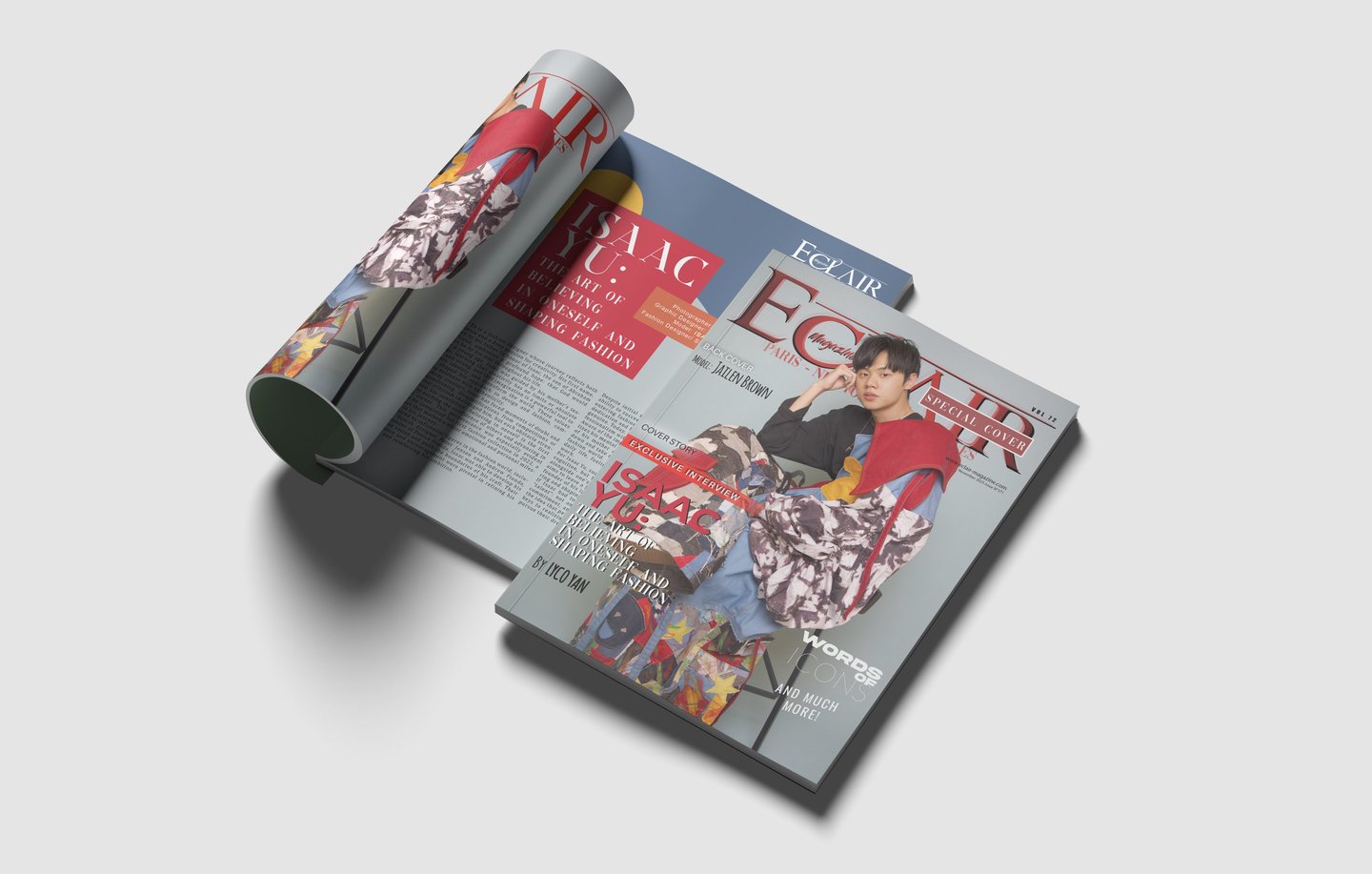EXCLUSIVE INTERVIEW
Isaac Yu: The Art of Believing in Oneself and Shaping Fashion
Conducted by Guillaume Jean Lefebvre


1. In 2022, you completed your first fashion collection—a moment you described as deeply emotional. Can you share a specific challenge during that collection and how you overcame it?
I spent a year, from 2021 to 2022, completing my first collection. At that time, my overall construction skills were still developing—I wasn’t confident in patternmaking, draping, or sewing, which made finishing all the looks for my first collection a major challenge. British fashion designer Tamara Joseph became an invaluable mentor during that process. I would often send her my design sketches and ideas, and she patiently guided me step by step, helping me understand every detail of garment construction and supporting me until I completed the entire collection.
2. You mentioned being disqualified from a fashion show and facing doubts from others. How did one particular setback shape your approach to design or push you to evolve creatively?
The first fashion show opportunity in my life came right after I completed my first collection—the 2022 SCAD Fashion Show in Savannah, GA. Although it was a school event, not every designer was selected to showcase their work. A panel of more than twenty professional jurors from the fashion industry reviewed all the collections and chose only a few designers to present on stage.
My first collection, while meaningful to me, wasn’t bold or distinctive enough to stand out. Many considered it too simple and lacking unique features, and some people even doubted my design abilities. However, instead of giving up, I decided to pursue my master’s degree to refine my personal design style, deepen my fashion knowledge, and create more developed collections. Through this process, my work gradually improved year after year. This growth not only helped me overcome my initial failure but also strengthened my resilience and confidence as a designer.
3. Peter Jensen and Andrew Fionda were key mentors for you. Can you recall a specific lesson or piece of advice from them that changed the way you approach your designs?
Before I first met Peter and Andrew, they had already reviewed my previous designs. From their professional perspectives, they quickly recognized both the strengths and weaknesses in my work. They never changed my design ideas but instead offered valuable insights and advice to help strengthen my concepts. Their feedback often focused on design details, garment proportions, portfolio presentation, and creative direction.
Peter and Andrew often provided and recommended many opportunities for me to present my portfolio, such as design competitions and portfolio reviews with major fashion brands like Bottega Veneta, Ralph Lauren, and Uniqlo, which greatly increased my exposure. Without Peter and Andrew’s guidance and support, I truly don’t think I could have become the designer I am today.
Isaac Yu is a fashion designer whose journey reflects both resilience and a deep passion for creativity. His first name, chosen by his father in honor of Isaac, the son of Abraham and Sarah, embodies a profound hope: that God would always be by his side throughout his life.
From a young age, Isaac was guided by his mother’s teachings, learning that creativity has no limits or absolute right and wrong, and that imagination is a powerful tool to express identity and transform the world. These values have shaped his approach to design and fashion, combining boldness with authenticity.
Like many creators, Isaac has faced moments of doubt and self-questioning. Disqualifications from competitions or external criticism challenged him, but each obstacle strengthened his conviction: believing in oneself is the first step to earning the confidence of others and advancing in one’s career. This perseverance was especially evident when he completed his first fashion collection in 2022, a project that marked a major emotional and personal milestone in his journey.
Mentored by influential figures in the fashion world, including Danish designer Peter Jensen and Andrew Fionda, co-founder of Pearce Fionda, Isaac was able to develop his unique vision and push the boundaries of his craft. Their guidance and encouragement were pivotal in refining his style and reinforcing his ambition.
Despite initial skepticism—particularly doubts about his ability to succeed in a field he knew nothing about before entering fashion school—Isaac demonstrated through his dedication and hard work that his passion and talent were genuine. Today, he is recognized for his creativity and professionalism within the industry.
Aware of the importance of personal balance, Isaac prioritizes his mental and emotional well-being with the support of his mother and partner, who encourage him to slow down and take care of himself despite the demands of the fashion world. Creativity and art remain central to his daily life, fueling his confidence and enthusiasm in his work.
For Isaac Yu, success is not measured solely by external recognition, but by achieving personal goals and evolving alongside one’s own aspirations. Through his career, he aims to leave a lasting impact—not only as a designer and founder of his label but also as a creator capable of inspiring and shaping the fashion industry.
If Isaac had to be described in one word, it would be “talent”: not an innate gift, but the result of discipline, commitment, and relentless effort. His journey embodies the idea that perseverance, passion, and self-belief are the keys to realizing one’s potential and inspiring others to pursue their dreams, no matter the obstacles they face.


INTERVIEW
4. Early in your journey, people doubted your choice to pursue fashion. Can you tell us about a moment when you proved yourself to someone, and how that felt?
Although many people once doubted my decision to pursue fashion, I never looked back or tried to prove them wrong. My motivation to grow and excel as a designer has always come from my genuine love for fashion and my dream of becoming a professional designer. That passion is what made me stronger and led me toward success.
The moment I truly felt I had proven myself was when I saw my designs featured on Vogue Runway and announced as a Gold Winner at the 2025 MUSE Design Awards and MUSE Creative Awards. It was then I realized that many of those who once doubted me were no longer around—but instead of resentment, I felt only gratitude. I was deeply thankful to God, my family, and my friends, who always believed in me, supported me, and never told me to give up.
5. You spoke about working tirelessly to learn fashion. Can you share a memory of a moment when your hard work directly resulted in a breakthrough or recognition?
I think the memory of that moment was very similar to the time I realized I had proven myself to those who once doubted me. When I returned to SCAD to pursue my master’s degree in fashion, it gave me a second chance to be considered for the fashion show. My 2025 collection, Who Kills My Freedom?, was selected by a panel of 20 jurors to be showcased in the 2025 SCAD Fashion Show in Atlanta. After the show, my designs were featured on Vogue Runway, and one of the looks was also exhibited at The Coca-Cola Company headquarters as part of an art showcase.
Seeing my work recognized and appreciated motivated me to take another step forward. A few months later, I submitted my collection to international competitions—the 2025 MUSE Design Awards and MUSE Creative Awards—and was honored to receive two Gold Awards in both categories. That was the moment I truly felt a breakthrough had happened—when I realized my work was no longer only being seen in the U.S., but also gaining recognition on a global stage.
6. Creativity and imagination have been guiding principles from your childhood. Can you give an example of a design or project where you fully embraced this freedom to experiment?
Yes, absolutely—my 2025 collection Who Kills My Freedom? is the perfect example of embracing the freedom to experiment. The inspiration came from a combination of my personal experience serving in the Taiwanese military and my childhood memories. As a Taiwanese male, military service is a requirement, and during that time, I felt depressed and stripped of my freedom. While serving, I often found myself longing for my childhood—the most creative and joyful period of my life.
After completing my service, I decided to channel that sense of childhood creativity into my designs, using fashion to express how those memories helped me rediscover my freedom. The collection features elements such as childlike collages, playful art, custom camouflage prints, and crayon-style drawings. It not only reflects my imagination and creative growth but also delivers a strong message: never let anything or anyone stop you from doing what you love. Be yourself and become the person you truly want to be.
7. Balancing personal well-being with a demanding career is challenging. Can you share a moment when taking a step back or listening to your mom or girlfriend helped you navigate a creative block?
Whenever I face new challenges, I tend to get overly nervous—and both my mom and my girlfriend know that well. My girlfriend, Ji Sun Kim, is a graphic designer who not only creates her own work but has also designed my branding logo, lookbook layout, swing tags, and more. Because she works in a creative field herself, she truly understands the struggles and pressures that designers face.
Both Ji Sun and my mom have always been the calm ones, reminding me to take a breath and approach things with patience and confidence. They’ve always believed in me, no matter what challenges I face. Ji Sun often gives me thoughtful suggestions and advice, helping me see different perspectives and solutions. I’m deeply grateful for both—they’ve always believed in me and have never once told me to give up.
8. You’ve said that believing in yourself is crucial. Can you recall a specific instance where self-doubt threatened a project, and how you overcame it?
My second collection—also the first one I created after deciding to pursue my master’s degree—was inspired by the aftermath of a car accident. It was the point where I challenged myself to create something bold and expressive, rather than focusing on market trends or commercial appeal. The design and construction process were extremely complex, and there were moments when I wanted to give up on fashion entirely and switch to another field. I struggled with constant self-doubt, but I knew that once I started, I had to finish.
In the end, I completed the collection, even though it wasn’t perfect to me. I treated the entire process as a valuable lesson. By the time I created my third and fourth collections—and later my 2025 Who Kills My Freedom?—my work had improved significantly each time. I’ve learned that experience is the only true way to grow. Every project comes with mistakes, but remembering them and applying those lessons to the next creation is what builds real progress and confidence as a designer.
9. Your first collection brought together perseverance and recognition. Was there a particular piece in that collection with a personal story or symbolic meaning?
I would say every look in my first collection carried a personal story and symbolic meaning. The collection was inspired by something I deeply love—breakdance—and it explored its positive energy and significance as a core part of Hip-Hop culture. However, the most personal and symbolic work I’ve created so far is still my 2025 collection, Who Kills My Freedom? It remains my most successful and distinctive project, as its inspiration came directly from my own life story. The collection expresses my emotions, personal journey, and transformation—from a period of depression to the creative and confident designer I’ve become today.
10. Looking back at your journey so far, is there a single moment that encapsulates your transformation from a beginner in fashion to a recognized designer?
Yes, I think that moment was when I began teaching myself fashion beyond the classroom. I was 20 years old and in my junior year of college when I realized that what we learn in fashion school provides only the foundation of design skills. While those lessons are essential, it’s impossible to learn everything in school—it requires continuous self-study.
I started creating personal projects outside of class, reading fashion articles, following global fashion news, and studying fashion history. These habits helped me build a stronger understanding of the industry and made my designs more refined—not only as visual art but also in relation to specific market needs. I believe knowledge is power, and since fashion moves quickly, self-learning has made my work more progressive, modern, and professional.




Photographer: Lyco Yan - @lyco.yan
Graphic Designer: Ji Sun Kim - @ji_sunnyk.im
Model: Isaac Yu - @imisaacyu
Fashion Designer/ Stylist: Isaac Yu - @imisaacyu
Quality, not quantity
We have made quality our habit. It’s not something that we just strive for – we live by this principle every day.
